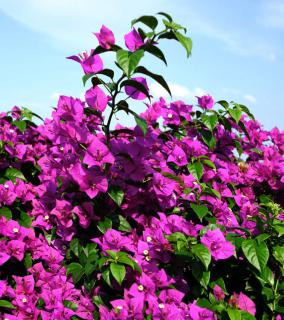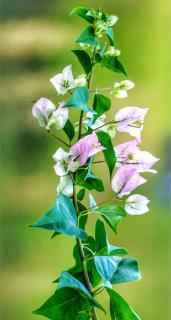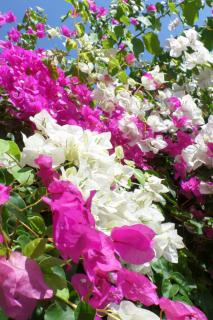

Bougainvillea are very beautiful Mediterranean climbing shrubs.
Name – Bougainvillea
Family – Nyctaginaceae
Type – climbing shrub
Exposure – full sun
Soil – rather light
Foliage – evergreen – Flowering – Summer
Caring and pruning are important to enhance growth and blooming of your bougainvillea.
Bougainvillea can survive outdoors year-round only in mild-wintered areas. They cannot withstand temperatures below freezing.
If you live around the Mediterranean, plant it in spring in light soil.
Caution – If the climate is right, a Bougainvillea planted in the ground will grow vigorously. Prune it carefully so it doesn’t get out of control.
Growing bougainvillea in pots is recommended everywhere temperatures drop below 32°F (0°C) during winter. You’ll have to bring them in a well-lit place where it doesn’t freeze over winter.
You’ll get spectacular flowers with special bougainvillea fertilizer
Pruning bougainvillea isn’t truly necessary, and cutting back drastically is even discouraged.

But it does make sense to balance the shape of the tree, or it might grow shapeless and lose appeal.
In that case, avoid pruning the entire bougainvillea: prune lightly and progressively over the years and the result will be perfect.
To boost flower-bearing, remove wilted flowers regularly (deadheading).
Water abundantly in summer, but reduce water intake in winter. Wait until the soil is dry before watering again.

Reduce fertilizer intake at the end of summer and stop adding it entirely at the beginning of fall.
You’ll get spectacular flowers with special bougainvillea fertilizer
Before frost spells hit, the plant must find cool shelter where it doesn’t freeze.
They like greenhouses or unheated lean-ins that have as much light as possible.
Only water when the soil is dry through and through.
This is the season to wake your bougainvillea up from its dormant state with regular watering.
As soon as frost spells are over, you may bring them back out.

A tropical plant (even sub-tropical), bougainvillea only appeared in Europe at the end of the 18th century, when botanist Philibert Commerson, member of the Brazilian exploration mission, discovered this plant, which he named bougainvillea in the honor of his commander Bougainville.
As flowers go, they have thus become symbols of adventure.
Blooming is abundant from spring to the end of fall, and its dark green leaves stay on the plant all year round.
Bougainvillea are among the fragrant climbing vines, but the fragrance is very light.
If you live in Northern regions and if it freezes in your area, you should grow it in pots so that it may be brought indoors out of the cold during winter.
For that, choose an unheated room where temperatures never drop below 45 to 50°F (8 to 10°C).
Leaves might fall off in winter after a cold spell. This doesn’t necessarily mean your tree is dead, it actually happens quite often.
Bougainvillea aren’t very vulnerable plants, especially if they can grow outdoors.
However, indoors, their natural growing environment must be reproduced to help it survive.
If leaves turn brown and curl, most probably aphids are colonizing the plant.
If leaves turn yellow suddenly, it is probably a scale insect invasion.
Read also on the topic of shrubs and climbing plants:
To produce spectacular blooms, add special bougainvillea organic fertilizer from spring to summer.